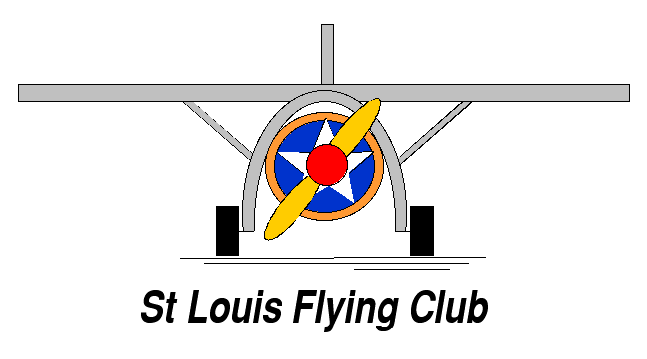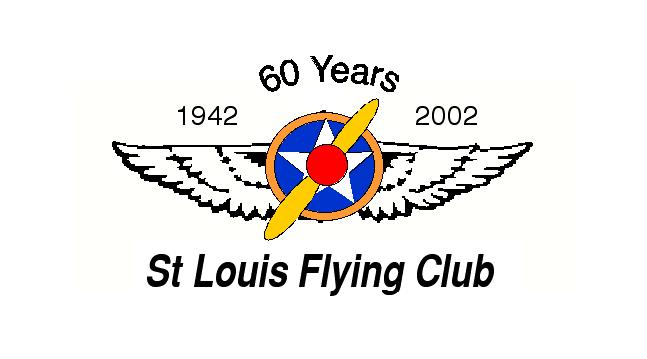 |
St. Louis Flying Club Newsletter - 19 February 2002 |
From The President - By Mike Piccirilli
 Dear Members,
Dear Members,I haven't received any feedback on the the improvement actions I listed in last month's newsletter, but then I haven't acted on my item either. I will include them again to keep them on our mind:
- Paint - I am still on the hook to get it from St. Charles.
- Intercom - John included info on intercoms in the last newsletter. Please provide John feedback, if you haven't so far. I authorize John to purchase whichever of those he feels good with.
- Avionics Fan - John, please coordinate with Randy on how many cooling ports are required and then decide on the right one. If you and Randy feel comfortable installing both the intercom and fan during the annual, great! Otherwise we need to coordinate with an avionics shop.
- Interior - We'll have to see how much money is left. At minimum, the headliner needs to be reglued during the annual. New carpeting would be easy to install at the annual also. I don't believe we have the money for any other improvements at this time.
Marlin had asked that I update the appraised value. I ran the numbers and the value was a couple % lower then last year. Since there are so many subjective variables (paint/interior, type of radio equipment) I feel that it would be best to just leave it at $49,000. This leaves us a nice round number (when divided by 7) and we don't have to fool with changing the insurance amount (Todd, please verify the plane is insured for $49,000).
There was alot of good discussions on leaning this past month between our e-mails. Thanks to John for coming up with the Lycoming article on it. I'll start leaning as soon as I get flying. Speaking of which I am planning on flying down to Hot Springs, Arkansas over Spring Break. Anybody been there?
Happy Landings!
Pic
![]()
 Treasurer's Report - by Marlin Sipe
Treasurer's Report - by Marlin Sipe
No news is good news. The Treasury had another nice increase this month, by about $350. We now have over $2600 for Annual, maintenance, and improvements.
![]()
 Maintenance - by John Heilmann
Maintenance - by John Heilmann
Randy worked on the carb heat control to see if he could keep it from backing out. I flew the plane on Sunday and the carb heat control knob still backs out about .3 inch after it is pushed all the way forward. We will look at it in more detail at the annual.
Randy also adjusted the #1 Radio and it worked fine when I flew on Sunday. Let us know if you have any problems with it.
The annual inspection is due in April. As soon as Randy gets back in town, we will be discussing the plans for the annual and aircraft improvements. The oil change is due in about 12 hours, so maybe it will last (or can be stretched) until the Annual. We have access to a hanger near C&D Aviation that we could use for the annual and aircraft improvement installations.
![]()
 St Louis Flying Club Logo - by John Heilmann
St Louis Flying Club Logo - by John Heilmann
What do you think about having a logo for the club. When you look at most other flying club websites, they all have logo's. Our club is now entering its 60th year of operation (1942-2002) and I think it would be great to have a logo that reflects its long history. Some possible Logo ideas that could be developed are shown on the left.  If anyone has other ideas or suggestins for a logo, please let me know. Once we decide on a logo, we can add it to the website and also add a Club Store where you can order shirts, sweatshirts, mugs, mousepads, etc if you want. The example "club store" link above will actually order the item you select and deliver it within a week if you enter all the requested data so be carefull. There is no cost to the club to set it up or maintain it and no mimimun order or set up fee.
If anyone has other ideas or suggestins for a logo, please let me know. Once we decide on a logo, we can add it to the website and also add a Club Store where you can order shirts, sweatshirts, mugs, mousepads, etc if you want. The example "club store" link above will actually order the item you select and deliver it within a week if you enter all the requested data so be carefull. There is no cost to the club to set it up or maintain it and no mimimun order or set up fee.
![]()
Various Lycoming Flyer articles have emphasized proper leaning at the manufacturer's recommended cruise power. Before delving into the savings to be obtained by leaning, it may be appropriate to again review those factors that affect leaning at cruise.
First we must know that cruise power for Lycoming normally aspirated engines is generally considered to be 55% to 75% of the maximum power for which the engine is rated. At these power settings, the engine may be leaned at any altitude. There has been confusion about the reference to not leaning below 5000-feet density altitude. Remember that this reference only applies to those power settings above the cruise range - those normally used for takeoff and climb. Once cruise power has been set, leaning to best economy should be standard procedure as damage to the engine will not occur from leaning at cruise power settings.
In this article we will expand our discussion of leaning and explain (1) how it saves dollars, and (2) how it aids safe flight. In a practical approach to our subject, let's look closely at the chart printed below:
Leaning the normally aspirated, direct drive Lycoming engine at cruise vs. full rich at 4,000 feet density altitude, 75% power.
- Engine/Airplane: 300 HP, Piper Cherokee 300
With Leaning: 5.1 hours at 15.6 gallons per hour
Full Rich: 4.2 hours at 19+ gallons per hour
- Engine/Airplane: 250 HP Piper Aztec
Best Economy: 5.1 hours at 13.6 gallons per hour
Full Rich: 4.3 hours at 16.2 gallons per hour
- Engine/Airplane: 180 HP Cessna Cardinal
Best Economy: 5.1 hours at 9.7 gallons per hour
Full Rich: 4.1 hours at 11.9 gallons per hour
To put the cost of operating at a full rich mixture setting during cruise flight into perspective, let us assume that the cost of aviation gasoline is $2.50 per gallon. In each case it is only necessary to multiply the difference in gallons burned at "Full Rich" vs. "Best Economy" times the fuel price. The number obtained will be the amount saved each hour of flight by operating at best economy during cruise. Using the examples above, these are the savings for each of those aircraft and engines:
Aircraft Fuel burn difference and Fuel cost savings
- Cherokee 300 - 3.4 gallons X $2.50 = $ 8.50 per hr.
- Aztec - 5.2 gallons X $2.50 = $13.00 per hr.
- Cardinal - 2.2 gallons X $2.50 = $ 5.50 per hr.
While we are on a discussion of unnecessary cost of operation, another important factor is the damage often done to engine accessories by operating at full rich at cruise power. Engines operating at full rich in cruise tend to be rough, resulting in shaking engine accessories and engine mounts, thereby considerably reducing their life and often resulting in expensive early replacement. A properly leaned engine at cruise power is a smooth engine - and will save money.
In earlier issues of the Flyer, we have been telling all concerned about the benefits to the spark plug of proper leaning at cruise power. That information can be repeated in this discussion because it helps to illustrate our point on saving dollars. Proper leaning at cruise helps prevent spark plug fouling. The maintenance cost to remove and clean spark plugs can be reduced by good leaning techniques. Frequent cleaning of spark plugs reduces their life and requires early replacement. Furthermore, badly fouled spark plugs could also become a safety-of-flight problem.
For a very interesting safety-of-flight item, let's look at the chart again. Notice the difference in hours of flight at full rich vs. lean at cruise. In the illustration of the 180 HP engine there is one full additional hour of flight when properly leaned. The other engines provide nearly an additional hour of flight time when leaned to best economy during cruise. This is a very real safety of flight fact.
These are some of the more important facts that illustrate how proper leaning at cruise power aids safe flight - and saves dollars.
![]()
 FAA Private and Instrument Test Questions
FAA Private and Instrument Test Questions
See how much you remember from your FAA Private Pilot and Instrument Rating Written Test by taking a quick 10 question test. Submit your answers and you will receive the correct answers and your score. (Don't worry, only you see the test results and your score.) This is a quick and easy way to keep familiar with the FARs. Use the links below and try to get a 100%:
The links above take you to Kip's FAA written Test Preparation Site. This site can be found directly at: http://w3.one.net/~kip/faatest.html
![]()
PAST NEWSLETTERS - Newsletter Archive
![]()
Copyright © 1999, St. Louis Flying Club, All rights reserved. Last updated 18 January 2002.